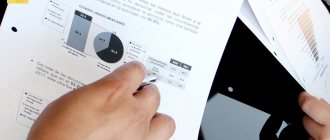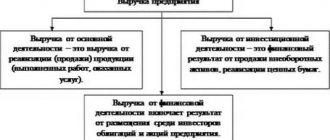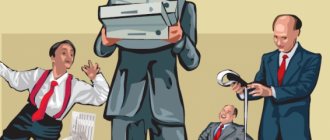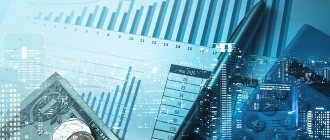Accrual method
Using the accrual method, include revenue in the tax base at the time the goods are sold. It does not matter when payment was received from buyers. Such rules are established by paragraph 3 of Article 271 of the Tax Code of the Russian Federation.
Situation: at what point should an organization calculating income tax using the accrual method include sales revenue as income? Under a supply agreement, ownership of the shipped goods passes to the buyer at the time of payment.
Include proceeds from sales as income at the time the buyer pays for the goods.
When calculating income tax, revenue arises in the period in which the goods (work, services) were sold (clause 3 of Article 271 of the Tax Code of the Russian Federation). Sales means the transfer of ownership of shipped goods (Clause 1, Article 39 of the Tax Code of the Russian Federation).
As a general rule, the acquirer's right of ownership of a thing arises from the moment of its transfer. But the parties to the contract may provide for a different procedure. For example, until payment for shipped goods, the seller may remain their owner. This follows from paragraph 1 of Article 223 of the Civil Code of the Russian Federation. Thus, if, under the terms of the contract, ownership of the goods passes to the buyer after payment, the proceeds must be included in income when calculating income tax on the date of payment.
Similar clarifications are contained in letters of the Ministry of Finance of Russia dated November 9, 2010 No. 03-03-06/700 and dated July 20, 2006 No. 03-03-04/1/598. In arbitration practice there are examples of court decisions that confirm the legality of this approach (see, for example, the resolution of the Federal Antimonopoly Service of the Ural District dated December 12, 2007 No. F09-9778/07-SZ).
Note: In order for the seller to recognize sales revenue on the payment date, the seller must be able to control the buyer's use of the goods.
If the contract states that ownership of the goods passes to the buyer at the time of payment, then until that moment he has no right to dispose of the goods received (Article 491 of the Civil Code of the Russian Federation). But for the seller to recognize sales revenue on the payment date, it must be able to control the buyer's use of the goods. If the seller does not have such an opportunity, the moment of transfer of ownership does not matter for the recognition of income from the sale. Lack of control over the shipped goods means that, in fact, ownership has passed to the buyer. In such a situation, the seller must recognize sales revenue on a general basis - at the time of shipment. This conclusion is confirmed by the letter of the Ministry of Finance of Russia dated September 20, 2006 No. 03-03-04/1/667 and paragraph 7 of the information letter of the Presidium of the Supreme Arbitration Court of the Russian Federation dated December 22, 2005 No. 98.
More found about net revenue
- Forecasting the balance sheet of a commercial organization using the percentage of sales method This means that both current assets and short-term liabilities will be the same percentage of net sales revenue in the forecast period 2. The percentage increase in the value of fixed assets is calculated for a given percentage increase
- Analysis of the financial results of a commercial organization according to the profit and loss statement. In this case, during the analysis of the structure, net sales revenue is taken as 100% as the largest positive indicator. Based on the results of analytical calculations, a conclusion is drawn about
- Methodology for analyzing current assets of a commercial organization ВРн – net revenue from sales ObАср – average balances of current assets for the period D – number
- Analysis of the arbitration manager To calculate the ratios of the debtor's financial and economic activities, the following main indicators are used: a total assets liabilities - balance sheet currency balance sheet assets liabilities total assets liabilities page 1600 b adjusted non-current assets - the sum of the value of intangible assets without goodwill and organizational expenses of fixed assets without capital costs for leased fixed assets in-progress capital investments without incomplete capital costs for leased fixed assets income-generating investments in material assets long-term financial investments other non-current assets adjusted non-current assets line 1110 line 1120 line 1130 line 1140 line 1150 – capital costs for leased fixed assets line 1160 line 1170 p. 1190 in current assets - the sum of the value of inventories without the cost of shipped goods long-term receivables of liquid assets value added tax on acquired assets debts of founder members for contributions to the authorized capital of their own shares purchased from shareholders current assets p. 1200 g long-term receivables - receivables payments for which are expected more than 12 months after the reporting date d liquid assets - the sum of the value of the most liquid current assets short-term receivables other current assets liquid assets p. 1230 if the balance sheet does not have a breakdown into short-term and long-term p. 1240 p. 1250 p. 1260 e most liquid current assets - cash short-term financial investments without the cost of own shares purchased from shareholders the most liquid current assets page 1240 page 1250 g short-term accounts receivable - the sum of the cost of shipped goods accounts receivable payments for which are expected within 12 months after the reporting date without debt of the founders' participants for contributions to the authorized capital short-term receivables p. 1230 if the balance sheet does not have a breakdown into short-term and long-term s potential current assets for return - the amount of receivables written off at a loss and the amount of issued guarantees and sureties and own funds - the amount of capital and reserves for future income reserves for future expenses minus capital costs on leased property, debts of shareholders of participants for contributions to the authorized capital and the cost of own shares purchased from shareholders own funds line 1300 line 1530 line 1540 line 1430 – capital costs on leased property – line 1320 to liabilities of the debtor - the amount of current liabilities and long-term obligations of the debtor obligations of the debtor p. 1410 p. 1450 p. 1510 p. 1520 debt to the founders for payment of income p. 1550 l long-term liabilities of the debtor - the amount of loans and credits subject to repayment more than 12 months after the reporting date and other long-term liabilities long-term liabilities of the debtor p. 1410 p. 1450 m current liabilities of the debtor - the amount of loans and credits subject to repayment within 12 months after the reporting date accounts payable debt to the founders for the payment of income and other short-term obligations current liabilities of the debtor p. 1510 p. 1520 debt to the founders for the payment of income p. 1550 n net revenue - revenue from the sale of goods, performance of work, provision of services, minus value added tax, excise taxes and other similar mandatory payments, net revenue p. 2110 p average monthly revenue - the ratio of the amount of gross revenue received for a certain
- Analysis of financial and economic activities for the administrations of constituent entities of the Russian Federation To calculate the coefficients of the debtor’s financial and economic activities, the following main indicators are used: a total assets and liabilities - balance sheet currency of the balance sheet of assets and liabilities b adjusted non-current assets - the sum of the value of intangible assets without goodwill and organizational expenses of fixed assets without capital costs for leased fixed assets in-progress capital investments without incomplete capital costs for leased fixed assets income-generating investments in material assets long-term financial investments other non-current assets in current assets - the sum of the cost of inventories without the cost of shipped goods long-term accounts receivable liquid assets value added tax on acquired assets debts of the founder members for contributions to the authorized capital of their own shares purchased from shareholders d long-term receivables - receivables for which payments are expected more than 12 months after the reporting date d liquid assets - the sum of the value of the most liquid current assets short-term receivables other current assets e the most liquid current assets - cash short-term financial investments without the cost of own shares purchased from shareholders w short-term receivables - the sum of the cost of shipped goods accounts receivable payments for which are expected within 12 months after the reporting date without debt of the founders for contributions to the authorized capital z potential current working capital assets to be returned - the amount of receivables written off at a loss and the amount of issued guarantees and sureties and own funds - the amount of capital and reserves for deferred income reserves for future expenses minus capital costs for leased property debt of shareholders of participants for contributions to the authorized capital and the cost of own shares repurchased for shareholders k liabilities of the debtor - the amount of current liabilities and long-term obligations of the debtor l long-term liabilities of the debtor - the amount of loans and credits to be repaid more than 12 months after the reporting date and other long-term liabilities m current liabilities of the debtor - the amount of loans and credits to be repaid within 12 months after the reporting date, accounts payable debt to founder members for the payment of income and other short-term obligations n net revenue - revenue from the sale of goods, performance of work, provision of services, minus tax on
- Analysis of consolidated and segment reporting: methodological aspect Asset turnover ratio Net sales revenue Average balance sheet currency 4.3. Return on sales Profit from sales Net revenue
- Current issues and modern experience in analyzing the financial condition of organizations - part 8 THEIR CALCULATION 1. To calculate the coefficients of the debtor’s financial and economic activities, the following main indicators are used: a total assets liabilities balance sheet currency balance sheet assets liabilities b adjusted non-current assets the sum of the value of intangible assets without business reputation and organizational expenses of fixed assets without capital expenditures on leased fixed assets in-progress capital investments without incomplete capital expenditures on leased fixed assets income-generating investments in material assets long-term financial investments of other non-current assets in current assets the sum of the cost of inventories without the cost of shipped goods long-term accounts receivable liquid assets value added tax the value of the acquired assets of the debt of the founders' participants for contributions to the authorized capital of their own shares purchased from shareholders d long-term receivables receivables payments for which are expected more than 12 months after the reporting date d liquid assets the sum of the value of the most liquid current assets short-term receivables other current assets f the most liquid current assets cash short-term financial investments without the cost of own shares purchased from shareholders g short-term receivables the amount of the cost of shipped goods receivables payments for which are expected within 12 months after the reporting date without debt of the founders for contributions to the authorized capital h potential current working capital assets to be returned written off at a loss the amount of receivables and the amount of issued guarantees and guarantees and own funds the amount of capital and reserves for deferred income reserves for future expenses minus capital costs for leased property debt of shareholders of participants for contributions to the authorized capital and the cost of own shares purchased from shareholders k liabilities of the debtor the amount of current liabilities and long-term liabilities of the debtor l long-term liabilities of the debtor the amount of loans and credits subject to repayment more than 12 months after the reporting date and other long-term liabilities m current liabilities of the debtor the amount of loans and credits subject to repayment within 12 months after the reporting date of the creditor debts owed to the founders for payment of income and other short-term obligations n net revenue revenue from the sale of goods performance of work provision of services minus value added tax
- Profitability: to manage, it is necessary to measure correctly Deneb Rychal-Su 1 Net revenue from the sale of goods minus VAT, excise taxes and similar mandatory payments 1472296 1314959
- Estimation of the duration of accounts receivable (using the example of Sever Electro OJSC) NS – net revenue from all types of sales or provision of services Net Sales in soms 1, s
- Analysis of the FCD to identify signs of deliberate bankruptcy To calculate the coefficients of the debtor’s financial and economic activities, the following main indicators are used: a total assets and liabilities - balance sheet currency of the balance sheet of assets and liabilities page of the balance sheet 300 b adjusted non-current assets - the sum of the value of intangible assets without goodwill and organizational expenses of fixed assets without capital expenditures on leased fixed assets in-progress capital investments without incomplete capital expenditures on leased fixed assets income-generating investments in material assets long-term financial investments other non-current assets balance sheet pages 190-145 in current assets - the sum of the cost of inventories excluding the cost of shipped goods long-term receivables of liquid assets value added tax on acquired assets debts of founder members for contributions to the authorized capital of their own shares purchased from shareholders balance sheet pages 210-215 230 240 250 260 270 220 244 252 g long-term receivables - receivables for which payments are expected more than 12 months after reporting date balance sheet page 230 d liquid assets - the sum of the cost of the most liquid current assets short-term accounts receivable other current assets balance sheet page 240 250 260 270 short-term accounts receivable - the sum of the cost of shipped goods accounts receivable payments for which are expected within 12 months after the reporting date without debt founder members for contributions to the authorized capital e the most liquid current assets - cash short-term financial investments without the cost of own shares purchased from shareholders balance sheet page 250 260 g short-term receivables - the sum of the cost of shipped goods receivables payments for which are expected within 12 months after the reporting period dates without indebtedness of the founder members for contributions to the authorized capital of the balance sheet page 215 240-244 s potential current assets for return - the amount of receivables written off at a loss and the amount of issued guarantees and sureties and own funds - the amount of capital and reserves for deferred income reserves for future expenses for deduction of capital costs for leased property, debt of shareholders of participants for contributions to the authorized capital and the cost of own shares purchased from shareholders, balance sheet page 490 640 650-244-252 k liabilities of the debtor - the sum of current liabilities and long-term obligations of the debtor l long-term liabilities of the debtor - the sum of loans and credits subject to repayment more than 12 months after the reporting date and other long-term liabilities balance sheet page 510 520 m current liabilities of the debtor - the amount of loans and credits subject to repayment within 12 months after the reporting date accounts payable debt to founder members for the payment of income and other short-term liabilities balance sheet page 610 620 630 660 n net revenue - revenue from the sale of goods, performance of work, provision of services, minus tax on
- Assessment of the borrower's creditworthiness according to the financial statements K7 Net proceeds from sale Average value of assets F No. 2, line 010 F No. 1,
- Financial analysis for the arbitration manager indicator 01.01.2006 01.10.2006 Change A total assets of passives 136700 72658 -64042 b adjusted non -current assets 115017 61723 -53294 B1 capital costs for rented fixed assets 2 0 B2 incomplete capital costs for leased fixed assets 4 74 70 70 70 70 70 in current assets 21677 10859 -10818 g long-term receivables 1104 1556 452 d liquid assets 7733 4808 -2925 f most liquid current assets 61 11 -50 g short-term receivables 7672 4797 -2875 z potential current assets to be returned from amount of accounts receivable written at a loss and the amount of issued guarantees and sureties 1764 197 -1567 and own funds 77849 55979 -21870 to the obligations of the debtor 58849 16677 -42172 l long-term liabilities of the debtor 19883 1970 -17913 m current liabilities of the debtor 38966 14707 -24259 with overdue accounts payable 6 -6 for 9 months 2005 for 9 months of 2006 net revenue 26098 6864 -19234 gross revenue revenue from sales of goods performance of work rendering
- Rules for conducting financial analysis by the arbitration manager FOR THEIR CALCULATION 1. To calculate the coefficients of the debtor’s financial and economic activities, the following main indicators are used: a total assets and liabilities - balance sheet currency of the balance sheet of assets and liabilities b adjusted non-current assets - the sum of the value of intangible assets without goodwill and organizational expenses of fixed assets without capital expenditures on leased fixed assets in-progress capital investments without incomplete capital expenditures on leased fixed assets income-generating investments in material assets long-term financial investments other non-current assets in current assets - the sum of the cost of inventories excluding the cost of shipped goods long-term receivables liquid assets value added tax acquired values of debt of founder members for contributions to the authorized capital of their own shares purchased from shareholders d long-term receivables - receivables payments for which are expected more than 12 months after the reporting date d liquid assets - the sum of the value of the most liquid current assets short-term receivables other current assets f the most liquid current assets - cash, short-term financial investments without the cost of own shares purchased from shareholders g short-term receivables - the sum of the cost of shipped goods, receivables for which payments are expected within 12 months after the reporting date without debt of the founders for contributions to the authorized capital h potential current assets for return - the amount of receivables written off at a loss and the amount of issued guarantees and sureties and own funds - the amount of capital and reserves for deferred income reserves for future expenses minus capital costs for leased property debts of shareholders of participants for contributions to the authorized capital and the cost of own shares purchased from shareholders k liabilities of the debtor - the amount of current liabilities and long-term liabilities of the debtor l long-term liabilities of the debtor - the amount of loans and credits subject to repayment more than 12 months after the reporting date and other long-term liabilities m current liabilities of the debtor - the amount of loans and credits subject to repayment in within 12 months after the reporting date, accounts payable indebtedness to founder members for the payment of income and other short-term obligations n net revenue - revenue from the sale of goods, performance of work, provision of services, minus tax on
- Completeness and reliability of the debtor's financial analysis in bankruptcy proceedings VN Net proceeds Revenue from the sale of goods, performance of work, provision of services, minus value added tax
- Research of non-current assets of the enterprise for the purposes of financial analysis The report on financial results contains the following items: revenue from the sale of goods products works services minus value added tax excise taxes and other taxes and mandatory payments net revenue cost of sales of goods products works services excluding commercial and administrative expenses commercial expenses
- Financial potential of an enterprise: concept, essence, measurement methods According to these formulas, the volume of net financial resources is determined since the financial results statement reflects net revenue from the sale of goods, works, services. It should be noted that these formulas can be used to determine
- Profit rate The net profit rate is measured as a percentage and is defined as the ratio of net profit to net revenue. The analysis of the net profit rate is carried out in the FinEkAnalysis program in the FCD Analysis block on
- Risk assessment of the probability of bankruptcy using logit models NP PE 100 B where B is net revenue, i.e. minus indirect taxes 1 The names of the indicators and their characteristics are given
- On the standard values of coefficients when forming a rating assessment of the financial and economic condition of an enterprise Line code Net revenue from the sale of goods, products, works, services B 2110 Cost of goods sold, products, works
- Assessment of the financial performance of mergers and acquisitions Indicator Amount Net revenue from sales of goods, products, services, works, minus excise taxes of value added tax
Cash method
If the organization uses the cash method, then all of the listed expenses will reduce the proceeds from sales, subject to their payment (clause 3 of Article 273 of the Tax Code of the Russian Federation).
Situation: at what point can the purchase price of goods sold be included in expenses when calculating income tax? The selling organization determines income and expenses using the cash method.
With the cash method, the purchase price of goods sold can be expensed only after payment has been received from customers.
The validity of this conclusion is due to the following.
The seller has the right to reduce income from the sale of goods by the cost of their acquisition (subclause 3, clause 1, article 268 of the Tax Code of the Russian Federation). From the literal interpretation of this rule, it follows that the moment of recognition of income from sales must precede (or coincide in time) the moment of writing off expenses in the form of the purchase price of goods sold.
The date of receipt of income for organizations that calculate income tax using the cash method is the day the payment is received (clause 2 of Article 273 of the Tax Code of the Russian Federation). Article 268 of the Tax Code of the Russian Federation does not provide for any specific features of recognizing income and expenses when selling goods for organizations using the cash method.
Thus, with the cash method, the purchase price of goods can be written off as expenses if two conditions are simultaneously met:
- the goods have been paid to the supplier (clause 3 of Article 273 of the Tax Code of the Russian Federation);
- the goods were sold to the buyer (clause 1 of article 268 of the Tax Code of the Russian Federation).
The cost of sold purchased goods must be assessed in one of three possible ways: FIFO, at the average cost or at the cost of a unit of goods (subclause 3, clause 1, article 268 of the Tax Code of the Russian Federation).
Advice : with the cash method, the best option for valuing purchased goods is at the cost of a unit of goods. If you organize detailed analytical accounting, you can easily determine when certain goods were purchased, paid for and sold.
It is difficult to use other methods of valuing purchased goods using the cash method. Often, batches of goods are paid to suppliers and sold to customers in parts, in different reporting and even tax periods. Moreover, both paid and unpaid goods can be shipped to customers. In such situations, it is very difficult to monitor compliance with all the conditions necessary to include the cost of goods sold as an expense.
What is revenue in a business?
The revenue of a commercial enterprise is usually understood as the amount (or a list of property in value terms) that it received as a result of sales or provision of services within a certain period of time. Based on the difference between revenue and expenses (and sometimes only on the basis of the value of the first indicator), the amount of taxes that the company must pay to the state is determined. The exception is the taxation mechanism, in which the corresponding cash receipts to the enterprise account are not taken into account: such schemes include, for example, the UTII system provided for by Russian legislation.
It is worth noting that, in accordance with some financial analysis methods, revenue as an economically significant indicator can be reduced by taxes (in this case it is called “net revenue”).
A common approach according to which revenue is classified is:
- on cash receipts from the main type of commercial activity of the company;
- on proceeds from investments (for example, in the form of proceeds from the sale of securities);
- on revenue generated as a result of changes in exchange rates (for example, when exporting goods).
All three types of financial income are combined into total revenue. But, as a rule, business efficiency is assessed based on the income that is associated with the main activities of the enterprise.
A company's revenue can be calculated using two methods: cash and accrual. In the first case, it is recorded upon the fact that the enterprise accepts funds into its current account or cash register. In the second, it is calculated when the buyer of goods or consumer of services has obligations confirmed by contract or law related to payment for delivered products or services.
The main condition for receiving revenue from the main activity, regardless of the specific method of its calculation, is the sale of goods or services. Let's consider its specifics in more detail.
Direct and indirect costs
Direct costs include:
- the cost of purchasing the goods being sold;
- transportation costs for delivery of purchased goods to the warehouse of a trading organization (provided that these costs are not included in the purchase price).
Direct expenses can be taken into account in the tax base only as the goods to which they relate are sold. In this case, the cost of purchasing the goods being sold is resolved in one of three possible ways: FIFO, at average cost or at unit cost. Based on this, the cost of goods shipped but not sold at the end of the month cannot be included in income tax expenses.
All other expenses of a trade organization are considered indirect (except for non-operating expenses, the list of which is defined in Article 265 of the Tax Code of the Russian Federation). For example, employee salaries (including insurance premiums), amounts of accrued depreciation, packaging costs, pre-sale preparation of goods, etc. Such expenses reduce taxable profit regardless of the volume of goods sold. They should be written off in the month in which they arose, according to the rules of Article 272 of the Tax Code of the Russian Federation.
This follows from the provisions of Article 320 of the Tax Code of the Russian Federation. Similar clarifications are contained in the letter of the Ministry of Finance of Russia dated September 4, 2012 No. 03-03-06/1/465.
Table
| Revenue | Implementation |
| What do they have in common? | |
| The successful sale of a product or service is the main condition for the generation of revenue from the company’s main activity | |
| What is the difference between them? | |
| Represents the amount of money received by an organization as a result of commercial activities | Represents the direction of the company’s commercial activity, which is associated with the sale of goods and services |
| Not always related to the sale of goods and services (maybe, for example, investment) | Almost always associated with the sale of goods and services |
Revenue in the consolidated balance sheet
In the consolidated statements, revenue is reported by areas of profit. This allows us to highlight those types of activities that are dominant in the formation of the enterprise’s revenue. In addition, revenue here is generated not only by RusHydro itself, but also through sales and sales to other electric companies in the Far Eastern Federal District (FEFD).
Consolidated balance sheets are usually provided by large companies with a complex capital structure
In domestic reporting under RAS, Revenue is reflected in line 2110 ↓
In RAS, Revenue is reflected in line 2110
Cost price
Let's move on to the classification of expenses. The first type of expense is cost (Cost of Goods) . These are the costs of manufacturing and selling products, performing work, and providing services. Next I will talk about products, meaning work and services too.
It seems like a simple definition, but it is important to understand that the cost varies. Each of the calculated costs is analyzed for its own purposes. And, if the cost of production is 100 rubles, and the sales revenue is 150 rubles, the profit from sales is not necessarily 50 rubles. Such information is not enough - you need to clarify exactly what cost we are talking about.
Manufacturing cost is the cost of making a product. It needs to be counted and broken down into components in order to understand what can be tweaked in the production process. Reduce waste of materials, switch to cheaper analogues, organize work more efficiently to reduce labor costs, etc.
The monthly production cost shows how much it cost to produce. But it is useless to compare it with revenue for three reasons.
- It is not enough to produce products, they must also be sold. And before it sells, store it somewhere. And all these are additional expenses that affect the financial result.
- Products that were started to be produced this month are not always released in the same month. The costs are already there, but there are no products yet. Such costs in accounting are called work in progress. And this is your asset.
- Products produced in a month are not always sold in the same month. This applies only to products; it is not relevant for works and services. If the products remain in stock, this is your asset.
When you look at the income statement, what you see is the manufacturing cost of goods sold. If you have a trading organization, everything is simpler. Instead of manufacturing cost, there is the cost at which you purchased the resold goods. In accounting, it is called the actual cost of goods.
Cost of sales (full cost) is the cost of manufacturing and selling products. Cost of sales consists of the production cost of products sold and the costs of selling them. It is this cost that must be compared with revenue to correctly determine the financial result.
Example 2. Horns and Hooves LLC produces cakes. During the day, 3 cakes were made and sold. To prepare them, food was purchased for 500 rubles, another 1000 rubles. was the pastry chef's salary. Cakes are sold on Instagram for 1000 rubles. The advertisement cost 2,000 rubles.
Production cost: 1500 rub. (500 rub. + 1000 rub.).
Cost of sales: 3500 rub. (1500 rub. + 2000 rub.).
Sales loss: 500 rub. (3000 rub. - 3500 rub.).
If the owner, when determining the financial result, was guided by production costs, he would decide that he owns a profitable business. But that's not true.
Example 3. Same conditions, but 2 cakes sold.
Production cost of production: 1500 rubles.
Cost of sales: 3000 rub. (2 * 500 rub. + 2000 rub.)
Sales loss: 1000 rub. (2000 rub. - 3000 rub.)
Another 500 rub. — production cost of the cake remaining in the warehouse. If tomorrow they buy it without advertising, then it will bring a profit of 500 rubles.
Other income
Other Revenue is any company income other than revenue:
- rent (for the lessor);
- dividends;
- income from the sale of fixed assets;
- interest on deposits;
- present.
The moment of recognition and measurement of the amount of other income are determined in the same way as for revenue. The exception is gifts. There is no receivable due to a gift, so income is determined based on the market value of the gifted asset.
The division of income into revenue and other income depends on what the company does. For a store, rent is other income, and for a leasing company, it is revenue. The accrued dividends will be revenue for the qualified investor, but other income for the plant. And only gifts qualify as income except from a professional kept woman.
Can revenue be negative?
One of the differences between profit and revenue is that the second indicator is never negative, that is, it is impossible to obtain negative revenue. This is due to the fact that nothing is subtracted when calculating revenue. When this indicator is zero, the company does not receive money.
Revenue cannot be ignored when analyzing a company’s activities. This is an important financial component. Thanks to it, you can find out what goods and services are in demand and how financially successful the company is. Revenue also helps determine what volume of products to produce and at what cost to sell it.
Operational risk coefficient – reflects the impact of overhead costs.
The calculation formula is as follows:









